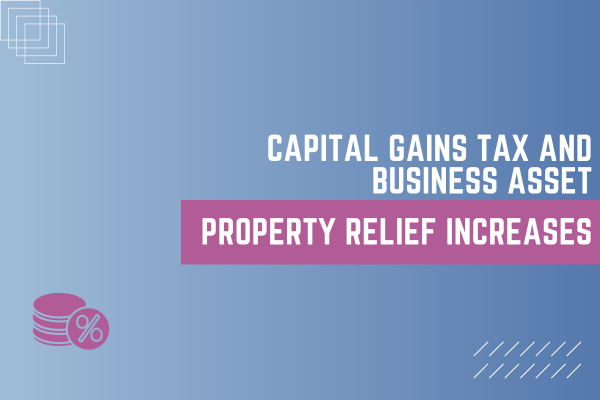- 01253 731791
- 9AM - 5PM Mon - Fri
- Bank House, 9 Dicconson Terrace, Lytham St Annes, FY8 5JY
Timeframe: Immediate
Action points:
Capital Gains tax rates for disposal on or after 30 October 2024 will increase from 10% to 18% and the higher rate from 20% to 24%.
The rate for Business Asset Disposal Relief and Investors’ Relief will increase to 14% from 6 April 2025 and will increase again to match the lower main rate at 18% from 6 April 2026.
Planning points:
If you’re considering selling or closing a business, the 2024 Autumn Budget changes to Capital Gains Tax (CGT) and Business Asset Disposal Relief (BADR) will impact your financial planning.
Here are practical planning points to help you manage this transition effectively:
Evaluate the optimal timing of sale or closure
- Understand the new tax rates: With higher CGT rates, it’s essential to know the exact impact on your sale proceeds. If possible, explore delaying the sale to assess if future tax adjustments might be more favourable.
- Plan sales to optimise tax years: If your business has multiple assets, selling them over multiple tax years may allow you to make better use of annual CGT exemptions and spread the tax impact.
Maximise Business Asset Disposal Relief (BADR)
- Ensure eligibility: BADR, which reduces the CGT rate on qualifying assets, now has more restrictions. Confirm you meet criteria like minimum ownership periods (at least two years) and active involvement in the business. Keeping records of your involvement, shareholding, and any key changes in ownership will help prove eligibility.
- Use BADR efficiently: BADR has a lifetime limit, so if you’re eligible, plan to use it on the largest possible sale or exit proceeds, as you may only get one opportunity. Consult a tax advisor to help maximise this relief.
Prepare for higher tax on sale proceeds
- Budget for increased CGT costs: Calculate CGT on expected sale proceeds to plan accurately for post-sale cash flow. Setting aside funds for the CGT bill in a dedicated reserve account is advisable to avoid any cash flow crunch.
- Estimate net proceeds: Use current CGT rates and reliefs to calculate net proceeds after taxes. This will provide a clear picture of your available funds post-sale, so you can make informed decisions about next steps.
Consider an Earn-Out Arrangement
- Structure sales over time: An earn-out arrangement, where part of the sale proceeds is received over a set period, could help reduce immediate CGT liability. Since you’re only taxed on proceeds received each tax year, this structure may spread the tax impact.
- Align with buyer’s payment preferences: Buyers often prefer paying in instalments, so structuring a sale this way could also attract more offers while benefiting your tax position.
Plan for personal tax implications
- Consider Dividends vs. Salary: If you’re still involved in the business, plan how much you take as dividends versus salary. Dividends could reduce CGT impact if you’re planning to leave the business over time rather than exit suddenly.
- Explore gifting options: For family-owned businesses, gifting shares or ownership to family members may defer or minimise CGT in some cases. Holdover relief may apply, allowing CGT to be postponed until the recipient disposes of the asset.
Use tax efficient investment strategies post sale
- Consider pensions or ISAs: Reinvesting sale proceeds into pensions, ISAs, or other tax-efficient investments can help reduce the personal tax burden on funds after your exit.
- Explore EIS or SEIS for reinvestment: If you’re open to reinvesting in other businesses, the Enterprise Investment Scheme (EIS) or Seed Enterprise Investment Scheme (SEIS) can reduce CGT and provide relief on new investments. This could be useful if you plan to reinvest proceeds from the sale.
Evaluate the costs and benefits of closing versus selling
- Compare tax impacts: In some cases, closing the business might yield a different tax impact than selling, especially if you can make use of any remaining loss reliefs. Review both options to see which aligns better with your financial goals and CGT liability.
- Plan for asset disposal separately: If your business owns high-value assets (such as property), selling these before closing could allow you to manage CGT in smaller amounts, potentially lowering the effective tax rate.
Work with a professional advisor
- Plan an efficient exit strategy: Given the complexities of increased CGT rates and changing relief rules, working with a tax advisor will help ensure that you’re fully aware of all available reliefs and can plan a tax-efficient exit strategy.
- Keep updated on tax law changes: As the landscape may continue to evolve, regular advice can help you stay informed on new options or reliefs that could impact your exit.
Set clear goals for your exit
- Prioritise cash flow or succession? If generating maximum cash is your top priority, the sale structure might differ from if succession planning is more important. For example, transferring ownership to family over time could provide CGT deferral opportunities, while an outright sale maximises immediate cash.
Being proactive with your planning will make the exit smoother and ensure you’re maximising your returns, even with the new CGT and relief rules.


